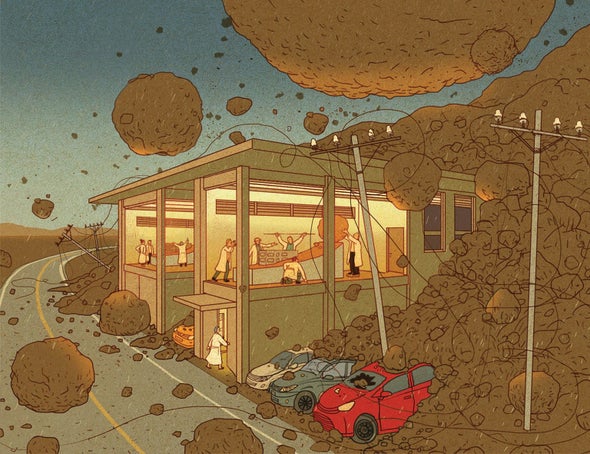This winter devastating floods and mudslides in California killed at least 17 people, closed roads for days and caused thousands to be evacuated. Mud and water ripped through the hillside town of Montecito five years to the day after a 2018 slide there killed 23 people and destroyed more than 100 homes.
Between 1998 and 2017 landslides and mudslides affected nearly five million people worldwide and took the lives of more than 18,000, according to the World Health Organization. In contrast, wildfires and volcanic activity killed 2,400. In the U.S. alone, slides and other debris flows kill 25 to 50 people every year. Yet by and large we don't hear very much about hazardous slides. Tornadoes, volcanoes, wildfires and hurricanes get more headlines. They get more scientific attention, too.
And climate change is making these slides more common. In fact, they are a prime example of the cascading effect of an altered climate: Drought leads to fires, which destroy the plants that anchor earth to hillsides, and that instability creates slides when rain finally comes. Drought isn't the only cause, either. Across Asia melting snow and ice are engorging rivers and undercutting hill slopes, making them prone to collapse. Last June a landslide after heavy rains in India killed 61 people.
Why don't scientists pay more attention to this threat? The U.S. Geological Survey has a landslide research program, but most universities don't. Richard Iverson, recently retired from the USGS after a career studying landslides and debris flows, told me that American research universities generally “avoid hiring faculty or training students to do this type of work.” To his knowledge, “no scientist who specializes in landslides/debris flows has ever been elected to the National Academy of Sciences.” A search of the academy's membership using the key word “landslide” turned up three names: a seismologist, a geophysicist specializing in theoretical rock mechanics, and a geologist specializing in biological forces shaping landscapes. None of the three works primarily on landslides.
One reason for this lack of research is money. U.S. federal funds for biomedical research soared to more than $25 billion a year between 1990 and 2000 and have stayed high. On the other hand, funding for everything else—physics, environmental sciences, other life sciences, mathematics and even computer science—has remained mostly flat. Environmental science, under which slide research falls, regularly has received less than $5 billion a year.
Another problem is that slides are notoriously hard to study. The basic idea is simple: a hillside becomes unstable when the force of gravity exceeds the forces holding it together. This happens when the hillside is undercut—for example, by an engorged river—or oversteepened or when friction is decreased by heavy rains. But because rocks and soils are highly variable, predicting when a particular hill will give way is almost impossible. It's hard to publish ambiguous results, so scientists may choose other research topics that seem more promising.
Slides suffer from siloed science, too. As one civil engineer put it, “Despite the high risk when extreme rainfall and droughts interact, most research in this area focuses on only one or the other. Different government agencies oversee flood and drought monitoring, warning and management, even though they are extremes of the same hydrological cycle.”
Scientists also like to take on things they find interesting, and slides appear to fall short. Many researchers think of their work as a kind of detective story, where “interesting” means understanding an underlying hidden mechanism. In cancer research, for instance, this has led to a focus on genetic causes of the disease instead of prevention. In earth science, it has prompted examinations of the internal processes of our planet. But slides aren't hidden. They happen quite clearly on the surface, and the mechanisms are in some ways obvious. Iverson put it this way: “Many scientists are most intrigued by things that are most mysterious.” Slides are catastrophic but not mysterious.
I don't fault scientists for wanting to study things they find fascinating. A lot of good work has been motivated by mystery. But researchers have to find a way to balance love of intrigue with a need to fix pressing problems such as the slippery ground underneath our feet.
This is an opinion and analysis article, and the views expressed by the author or authors are not necessarily those of Scientific American.


